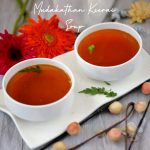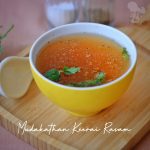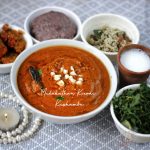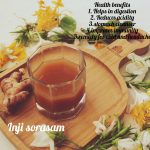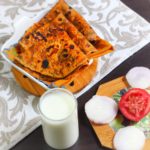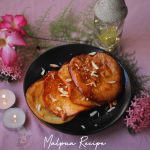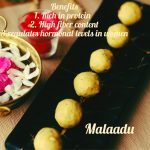Embark on a journey towards wellness with Mudakathan Raita as it is a sublime fusion of vibrant Mudakathan Keerai leaves and creamy yogurt, where each spoonful embodies the perfect balance between verdant freshness and velvety indulgence, creating a truly irresistible symphony of flavors. Delight in the wholesome goodness as the tender greens and luscious yogurt unite, delivering a palate-pleasing experience that's as nourishing as it is delectable.
Table Of Contents:
Just Glide Through These Topics Quickly To Surprise Yourself With Less known Facts:
1. Mudakthan Keerai Raita
2. A Brief Note On Mudakathan Keerai Raita
3. All About The Miracle Keerai Mudakathan
4. Geographical Factors Of Mudakathan Keerai
5. Ingredients Needed To Make Delicious Mudakathan Keerai Raita
6. Step Wise Directions To Make Mudakathan Keerai Raita
7. Cook Like A Pro
8. Nutritional Value
9. Faqs
10. Mudakathan Keerai Raita: A Nutshell
11. A Sample Menu With Mudakathan Keerai Raita
12. A Lovely Ambience To Enjoy Traditional Indian Lunch With Mudakathan Keerai Raita
13. The Takeaway
"Mudakathan Keerai Raita is a harmonious blend of vibrant South Indian flavors and wholesome nutrition. This unique raita showcases the goodness of Mudakathan Keerai, also known as Balloon Vine Leaves, expertly combined with creamy yogurt, fresh coconut paste and aromatic spices. As a testament to the rich heritage of Indian cuisine, this dish offers a refreshing twist to the classic raita, bringing together the earthy essence of indigenous greens, the soothing effect of fresh coconut and the cooling comfort of yogurt – a delightful blend that tantalizes the palate and nurtures the body."
A Brief Note On Mudakathan Keerai Raita:
Mudakathan Keerai Raita is a delightful South Indian dish that matches the goodness of Mudakathan Keerai, or Balloon Vine Leaves, with the creamy richness of yogurt. This unique raita combines finely chopped, steamed Mudakathan Keerai leaves with beaten yogurt and creamy coconut, creating a harmonious balance of flavors and textures. Seasoned with a touch of cumin and garnished with roasted cumin seeds and fresh coriander, this raita offers a refreshing and nutritious twist on the traditional yogurt-based side dish. The dish not only appeals to the taste buds but also celebrates the local flavors and health benefits of this indigenous leafy green.
All About The Miracle Keerai Mudakathan:
Mudakathan Keerai (Balloon Vine Leaves) has a rich history in Indian traditional medicine and cuisine. It has been used for its potential health benefits and culinary purposes for generations. Here's a brief overview of its origin and history in India:
Origin: Mudakathan Keerai, scientifically known as Cardiospermum halicacabum, is a vine plant that belongs to the Sapindaceae family. It is native to various regions across India, as well as parts of Southeast Asia and Africa. The plant is known by different names in various Indian languages, such as "Mudakattan" or "Mudakathan" in Tamil, "Kanphuti" in Hindi, and "Mundari" in Telugu.
Historical Use: Mudakathan Keerai has a long history of use in traditional Indian medicine systems, including Ayurveda and Siddha. It is believed to possess various medicinal properties and has been used to treat a range of ailments. Some traditional uses include:
Joint Health: Mudakathan Keerai has been used to alleviate joint pain and inflammation. It is believed to possess anti-inflammatory and analgesic properties.
Skin Disorders: Traditional medicine systems have employed Mudakathan Keerai to address skin-related issues such as itching, eczema, and other dermatological conditions.
Rheumatism: The leaves are sometimes used as a remedy for rheumatism and other musculoskeletal discomforts.
Respiratory Conditions: In some practices, Mudakathan Keerai is used to alleviate respiratory symptoms like cough and asthma.
Culinary Use: Apart from its medicinal applications, Mudakathan Keerai is also used in regional Indian cuisine, particularly in South India. It's often incorporated into dishes like rasam, chutneys, soups, and raitas and even kuzhambu and kootu varieties. Mudakathan keerai pakoras are a fantabulous feast which has the dual benefit of being healthy and as well as tasty. The leaves are valued for their unique flavor and potential nutritional benefits.
Modern Context: In recent times, there has been a growing interest in traditional and indigenous foods due to their potential health benefits and cultural significance. As a result, Mudakathan Keerai has gained attention not only for its historical use but also for its potential nutritional value as they are a good source of vitamins and minerals.
In ancient India, Mudakathan Keerai (Balloon Vine Leaves) was valued for its potential health benefits and was used in traditional medicine systems like Ayurveda and Siddha. The plant's use since several decades suggests that it had a significant role in ancient Indian culture. Here are some ways Mudakathan Keerai was used in ancient India:
Medicinal Use: Mudakathan Keerai was used as a medicinal herb in ancient Indian systems of medicine. It was believed to have properties that could help with various health conditions, such as joint pain, inflammation, skin disorders, and respiratory issues. The leaves and other parts of the plant were prepared and administered in different forms, such as decoction, pastes, or infusions, to address these ailments.
Geographical Factors Of Mudakathan Keerai:
- Nature: Climber
- Colour: Green
- Smell: Earthy
- Taste: Bitter
- Consistency: Tender
- Texture: Leafy
Culinary Use: While its primary use was medicinal, it's likely that people in ancient times also consumed Mudakathan Keerai as part of their diet. Many indigenous plants were incorporated into traditional diets for their nutritional value and potential health benefits including this mudakathan keerai. The leaves might have been cooked as a vegetable, added to kuzhambu, rasam, soups, or used in dishes like raitas.
Mudakathan Keerai (Balloon Vine Leaves) is a plant native to various regions across India and other parts of Asia and Africa. The plant's growth and distribution are influenced by a combination of geographical and environmental factors. Here are some of the key geographical factors that can affect the growth and presence of Mudakathan Keerai:
Climate: Mudakathan Keerai tends to thrive in warm and tropical climates. It prefers regions with a moderate to high temperature range throughout the year. The plant is well-suited to areas with temperatures that do not drop significantly below freezing.
Rainfall: Adequate rainfall is important for the growth of Mudakathan Keerai. The plant benefits from regions with a relatively consistent and well-distributed rainfall pattern. It may not do well in arid or desert-like conditions.
Altitude: Mudakathan Keerai is often found at lower altitudes. It tends to flourish in lowland areas rather than in high-altitude regions or mountainous terrain.
Soil Type: The plant prefers well-draining soil with good fertility. It can grow in a variety of soil types, including sandy and loamy soils. However, soil that retains too much water or is waterlogged might not be suitable.
Sunlight: Like most plants, Mudakathan Keerai requires ample sunlight to grow and thrive. It typically prefers areas with full to partial sunlight exposure.
Humidity: High humidity levels are generally favorable for the growth of Mudakathan Keerai. It's more likely to be found in regions with a relatively humid climate.
Natural Habitat: Mudakathan Keerai is often found growing as a weed in open fields, along roadsides, and in waste areas. It can also be found growing on fences and structures.
Geographical Distribution: Mudakathan Keerai is native to various parts of India, including regions in South India. It is also found in other countries across Asia and Africa, including countries like Sri Lanka, Malaysia, Thailand, and parts of East and West Africa.
It's important to note that while Mudakathan Keerai can be found in specific geographical conditions, it might also adapt to slightly different environments depending on the local conditions and other factors. Additionally, its presence and abundance can vary from one region to another, influenced by factors like human activity, habitat disturbance, and ecological interactions.
Local Wisdom: Ancient Indian communities often relied on local wisdom and indigenous knowledge for their well-being. Plants like Mudakathan Keerai were part of the local flora and were discovered through trial and error to possess certain properties that could contribute to health and wellness.
Traditional Remedies: The plant was often used as an ingredient in various herbal remedies and formulations. For example, in Ayurveda, Mudakathan Keerai might have been included in herbal concoctions or oils that were applied externally to alleviate joint pain or skin problems.
Here comes the simple yet delicious recipe of Mudakathan Keerai Raita:

Ingredients Needed To Make Delicious Mudakathan Keerai Raita:
Step Wise Directions To Make Mudakathan Keerai Raita:
Heat a saucepan and tip in a teaspoon of oil and scatter some urad dal and cumin seeds. When it starts to splutter throw in some chopped green chili and onion and lower the flame.

Just after a few seconds add a cup of fresh mudakathan keerai with the required amount of rock salt. Splash in a few drops of water and stir. Let it saute for a minute or two. When it is done, just turn off the flame and keep it aside.



Take a cup of fresh curd in bowl and plop in a quarter cup of plain coconut paste. Add this sauteed mudakathan keerai and mix altogether.



Strew In some cumin powder and fresh cilantro. Serve it as accompaniment for a full course lunch menu.



Cook Like A Pro:
Some Dos And Donts:
Dos:
Select Fresh Leaves: Choose fresh Mudakathan Keerai leaves that are vibrant in color and free from signs of wilting or decay. It is easily available at many vegetables shops and supermarkets nowadays.
Thorough Washing: Wash the leaves thoroughly to remove any dirt, tiny insects, or contaminants. This is especially important for wild greens like Mudakathan Keerai.
Blanching or Steaming: Consider blanching or steaming the Mudakathan Keerai leaves briefly before adding them to the raita. This can help soften the leaves and eliminate any bitterness.
Yogurt Consistency: Use plain curd or yogurt that is smooth and creamy. You can adjust the consistency by adding a little water or milk to achieve the desired thickness.
Balanced Flavors: Season the raita with a pinch of cumin powder and salt to enhance the flavors. You can also add finely chopped green chilies for a bit of heat if desired.
Garnishes: Garnish the mudakathan keerai raita with roasted cumin seeds and freshly chopped coriander leaves for added aroma and visual appeal.
Chilling Time: Allow the raita to chill in the refrigerator for a little while before serving. This helps the flavors meld together and enhances the overall taste.
Don'ts:
Don't Overcook Leaves: If you're blanching or steaming the Mudakathan Keerai leaves, be careful not to overcook them. They should retain their vibrant color, a slight crunch and complete nutritional value.
Avoid Using Sour Yogurt: While yogurt is a key ingredient, using overly sour yogurt can negatively affect the taste of the raita.
Don't Overpower the Greens: Mudakathan Keerai has a unique flavor, so be cautious not to overpower it with too many spices or seasonings.
Don't Skip Cleaning: Skipping the thorough cleaning of the leaves might lead to the presence of dirt or unwanted impurities in the raita.
Avoid Using Unfamiliar Greens: Ensure that you're using the correct plant and that it's identified correctly as mudakathan keerai and not anything which you do not know. Discard the green if you are not absolutely certain about.
Don't Make It Too Watery: While you can adjust the consistency of the raita, be cautious not to make it too watery. The raita should have a creamy texture that complements the Mudakathan Keerai.
Don't Skip Chilling: Allowing the raita to chill is important, as it helps the flavors meld. Skipping this step might result in a less flavorful dish.
Remember that culinary preferences can vary, so feel free to adjust these dos and don'ts based on your taste and familiarity with the ingredients. If you're new to using Mudakathan Keerai or making raita, you might want to start with a small batch and make adjustments as needed.
Faqs:
1. What is Mudakathan Keerai?
Mudakathan Keerai, also known as Balloon Vine Leaves or Heart-Leaved Moonseed, is a type of edible leafy green found in various parts of India and other regions. It is used both for its potential health benefits and culinary purposes.
2. What are the health benefits of Mudakathan Keerai?
Mudakathan Keerai is believed to have potential health benefits, including anti-inflammatory and analgesic properties. It has been traditionally used to address joint pain, skin disorders, and respiratory issues, among other conditions.
3. How is Mudakathan Keerai used in cooking?
Mudakathan Keerai is often used in South Indian cuisine. It can be added to dishes like soups, chutneys, and raitas. In Mudakathan Keerai Raita, the leaves are combined with yogurt, creating a nutritious and flavorful side dish.
4. How do I make Mudakathan Keerai Raita?
To make Mudakathan Keerai Raita, blanch or steam the chopped Mudakathan Keerai leaves, mix them with beaten plain yogurt, and season with salt and cumin powder. Garnish with roasted cumin seeds and chopped coriander. Refrigerate before serving.
5. Can I substitute Mudakathan Keerai with other greens?
While Mudakathan Keerai has its own distinct flavor, you can experiment with other leafy greens in raita recipes. Spinach or other edible greens might be good alternatives.
6. Can I store Mudakathan Keerai Raita?
Yes, you can store Mudakathan Keerai Raita in a breathable container in the refrigerator for a day and definitely not more than that. Because any green (keerai) based dish is not advisable to consume after a maximum of twenty four hours generally. And also, keep in mind that yogurt-based dishes might lose some texture and flavor upon prolonged storage.
7. Where can I learn more about traditional Indian greens and recipes?
You can explore local culinary traditions and practices, cookbooks, traditional medicine practices like Ayurveda, and online resources for more information about traditional Indian greens and recipes.
Mudakathan Keerai Raita: A Nutshell:
- Nature: Nutritious
- Colour: Creamy green
- Smell: Aromatic
- Taste: Refreshing blend of flavors
- Consistency: Smooth and creamy
- Texture: Creamy with tender bits of Mudakathan Keerai
A Sample Menu With Mudakathan Keerai Raita:
1. Main Dish:
- Mudakathan Keerai Rice: A flavorful rice dish cooked with Mudakathan Keerai leaves, spices, and rice. It can be prepared as a one-pot meal.
2. Side Dishes:
Mudakathan Keerai Raita: Creamy yogurt mixed with blanched Mudakathan Keerai leaves, seasoned with cumin and garnished with roasted cumin seeds and fresh coriander.
Lentil Curry (e.g., Sambar or Dal): A protein-rich lentil-based curry loaded with vegetables and aromatic spices.
3. Accompaniments:
Steamed Rice: Served as the base for the Mudakathan Keerai Rice and to enjoy with the lentil curry.
Roti or Chapati: A traditional Indian bread that complements the meal.
4. Salad:
- Fresh Vegetable Salad: A light and refreshing salad with mixed vegetables, seasoned with a simple dressing.
5. Dessert:
- Fresh Fruit Salad: A colorful assortment of seasonal fruits for a sweet and healthy ending to the meal.
6. Beverage:
- Buttermilk or Lassi: A cooling yogurt-based drink to accompany the meal.
A Lovely Ambience To Enjoy Traditional Indian Lunch With Mudakathan Keerai Raita:
Ambience: Rustic Garden Picnic
1. Outdoor Setting: Choose a spot in your garden or a nearby park with a natural backdrop of trees, flowers, or greenery. Lay down a comfortable blanket or picnic mat.
2. Table Setup: Place a low wooden table or a large tray at the center of the blanket. Decorate it with a simple cloth or table runner in earthy tones, like greens and browns.
3. Mood Lighting: If enjoying in the evening, hang string lights or place candles in lanterns around the area for a warm and cozy glow.
4. Seating: Arrange cushions or throw pillows around the blanket for comfortable seating. Add a touch of nature with cushions featuring botanical prints.
5. Tableware: Use natural, eco-friendly tableware like wooden plates, bamboo utensils, and cloth napkins. Consider using traditional brass or copper bowls for the raita.
6. Natural Elements: Place small potted plants or fresh flowers in vases on the table for a touch of nature. This brings the essence of the outdoors to your picnic setting.
7. Soft Music: Play gentle instrumental or acoustic music in the background to create a soothing atmosphere.
8. Picnic Basket: Pack your Mudakathan Keerai Raita and the rest of your meal in a charming picnic basket. Include vintage-style glass jars for beverages and small bowls for condiments.
9. Enjoyment: Sit back, relax, and savor the Mudakathan Keerai Raita along with the other dishes in the serene and natural setting you've created.
Remember, the goal is to create an environment that reflects your personal style and allows you to fully immerse yourself in the experience of enjoying your meal, especially the unique and nutritious Mudakathan Keerai Raita.
The Takeaway:
Mudakathan Keerai Raita, a culinary masterpiece that beautifully harmonizes the essence of traditional Indian greens with the creamy elegance of yogurt. With each velvety spoonful, it unveils a symphony of flavors that dances on the palate – the earthy richness of the leaves, the gentle tang of yogurt, and the aromatic embrace of spices.
A dish that not only tantalizes taste buds but also pays homage to the vibrant history and cultural tapestry of Indian cuisine. Mudakathan Keerai Raita is more than just a recipe; it's a delightful journey through flavors, tradition, and nature's bounty, encapsulated in every indulgent bite. Dedicate it to yourself and your family with pride and joy.
Happy Cooking!
Ingredients
Directions
Heat a saucepan and tip in a teaspoon of oil and scatter some urad dal and cumin seeds. When it starts to splutter throw in some chopped green chili and onion and lower the flame.



Just after a few seconds add a cup of fresh mudakathan keerai with the required amount of rock salt. Splash in a few drops of water and stir. Let it saute for a minute or two. When it is done, just turn off the flame and keep it aside.



Take a cup of fresh curd in bowl and plop in a quarter cup of plain coconut paste. Add this sauteed mudakathan keerai and mix altogether.



Strew In some cumin powder and fresh cilantro. Serve it as accompaniment for a full course lunch menu.




